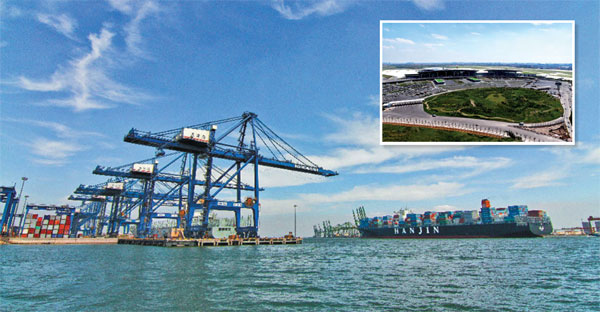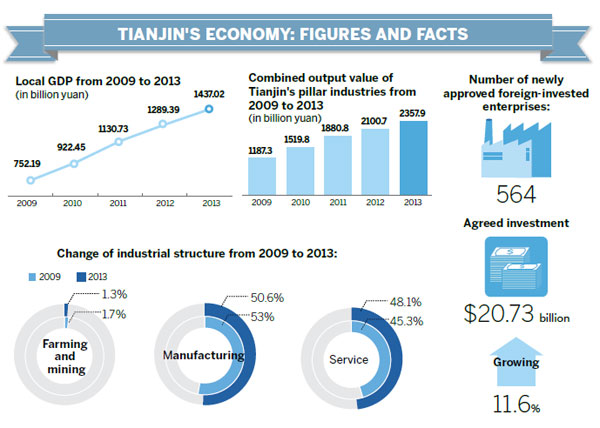'Ecological livable city' initiative carried out in city center, development zones and small towns, Gao Fei reports.
Local authorities are putting great efforts into making Tianjin an "ecological livable city" and notable results have been achieved in recent years.
The "Beautiful Tianjin" initiative proposed by the Tianjin municipal government, highlighted green projects across the city including the city center, Binhai New Area and small towns and rural regions.


According to a plan drafted by the Tianjin City Gardening Department, 25 new parks will be built and 17 existing ones will be updated in 2014, most of which are due to be finished before September.
In addition to the parks, other public facilities are also under construction, including ecological green paths.
Transport facilities are also included in the plan, with a focus on public transportation, to encourage environmentally friendly commuting.
Construction on subway Line 5 and Line 6 has been accelerated and work on Line 4 and Line 10 began recently.
Binhai New Area
The Binhai New Area is a highlight of the ecological livable city program.
According to the "Beautiful Binhai" plan, drafted by the area's government, the area's gross domestic product will reach 1.2 trillion yuan by 2016 with solid environmental development.
The plans indicate that by 2016, the annual concentration of PM 2.5 should have fallen by 20 percent from 2012, and 40 percent of land will be green.
As one of the four "future science cities" recognized by the central government, the Tianjin Future Science City also has ecological livable city construction as a top priority.
Tianjin Future Science City integrates Beijing, Tianjin and Hebei and receives science and education resources from Beijing's universities, medical institutions and scientific research facilities.
"For senior professionals, we help them develop careers here by offering venture capital, research services and other services," said Xia Xin, deputy director of the Administrative Commission of Tianjin Binhai High-tech Zone, where the science city is located.
"More importantly, we are trying to make their lives easier and more convenient here, for instance, helping them settle down and offering their children better schooling opportunities," Xia said.
The preferential policies have helped attract lots of projects and talented people. At present, more than 70 companies and institutions have settled in Binhai High-tech Zone, with a total of agreed investment of 74 billion yuan.
The zone highlights ecology in its planning and landscaping. In 2012, the Huayuan Science Park in the zone was named as a national eco-industry demonstration park.
It focuses on the development of low-carbon and eco-friendly industries.
The new energy industry in the zone is now home to household names from home and abroad including Tianjin Lishen Battery Co Ltd, BAK International (Tianjin) Ltd, Tianjin B&M Science and Technology Co Ltd.
The zone has formed a new energy industry cluster featuring wind power, solar power, LED and fuel cell batteries.
The Sino-Singapore Tianjin Eco-city, another demonstration area, has also sped up environmental improvement. It aims to achieve a 90 percent green commuting rate featuring new-energy, fuel-efficient public transportation and a 20 percent rate in resource recycling. In addition, all the buildings in the eco-city are required to meet environmental friendly or "green" standards.
Garbage classification is also used for better recycling of resources.
"We hope these measures can help control pollution and save resources," said He Dongyan, president of Tianjin Eco-city Investment & Development Co Ltd, the operator of the eco-city.
"We will further extend the sustainable development mode and make it in line with market mechanisms," he added.
Chen Jingxiang, a resident in Junliangcheng town in Tianjin's Dongli district, said he was happy to move into a new apartment in the Junhongyuan residential community.
"We lived in bungalows before, where life was hard and inconvenient," said Chen. "Now we have moved into the new building and the environment is far better and we can easily take buses to downtown Tianjin."
Junliangcheng is southeast of Tianjin's downtown area. It is one of the pilot project areas for the Tianjin initiative to urbanize small towns. The 1,100-hectare township will eventually be home to 150,000 residents, according to Dongli district government plans.
To date, about 23,000 people in Junliangcheng have moved into newly built apartments.
By the end of last year, Tianjin had invested 150 billion yuan in building residential facilities in 49 pilot towns.
About 44 million square meters of apartments for farmers are under construction and 23 million sq m have been completed for 450,000 farmers who have moved into new homes.
With the improvement of infrastructure and environment in former rural areas, Tianjin's urbanization rate has reached 82 percent.
By 2015, Tianjin hopes to transfer another 1 million rural residents to small towns, which is expected to boost the urbanization rate to 90 percent.
